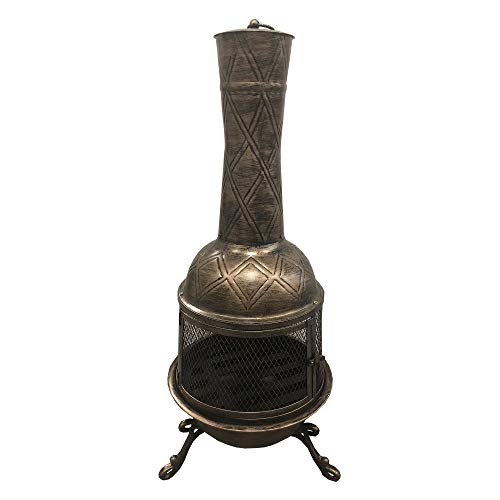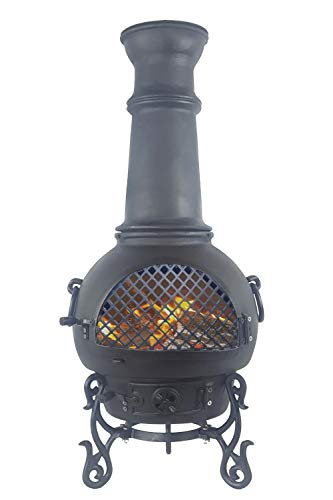9 Lessons Your Parents Teach You About Chiminea Terracotta
Josefa Cani
2024.11.28 05:42
184
0
본문
 A chiminea terracotta (please click the next webpage) Adds Warmth and Ambiance to Your Backyard Patio
A chiminea terracotta (please click the next webpage) Adds Warmth and Ambiance to Your Backyard Patio A chiminea adds warmth and ambiance to your backyard. Its chimney directs smoke upwards to keep the flames and sparks from destroying the surrounding plants and igniting your home or deck.
A chiminea adds warmth and ambiance to your backyard. Its chimney directs smoke upwards to keep the flames and sparks from destroying the surrounding plants and igniting your home or deck.Chimineas made of clay should be broken up slowly. The first few fires must be relatively small and slow-burning. The sealing of a big chiminea is recommended, particularly in rainy climates.
Material
A chiminea is an excellent option to add warmth and character to your backyard patio. The pot-belly design of the Chiminea is ideal for entertaining. However, more innovative designs are now available to fit different styles of decoration. While clay is the most popular material, chimineas can be made of aluminum or cast aluminum chiminea iron. Each material type has its distinct advantages. While clay is easy-to-maintain, metal is more durable. It also can endure higher temperatures.
When choosing a chiminea, consider its size, design and fuel type. The size of the chiminea must be able to hold the amount of wood you intend to use in order to maintain an even flame. The larger chimneys are suitable for large gatherings whereas smaller models work better in intimate spaces. A chimney directs smoke upward and protects the area from rain and preventing it from being blown around by strong winds.
The design of a chiminea is what makes it different from other outdoor fire pits. The bowl-shaped base holds the flames and protects them from wind, rain and other debris. The chimney is attractive and lets you control the size of flames.
Chimineas of clay can be made by hand before being fired at high temperature. They are usually coated with ceramic glaze to make them more appealing and durable against weather damage. Some are decorated in Mexican-inspired patterns. These chimineas can be purchased in garden stores and home improvement stores.
Before lighting a chiminea, it is recommended that you must cover the inside of the chiminea with coarse-grained gravel or sand. The sand reduces smoke and keeps the clay from cracking after being fired. Once you've covered your base, put small pieces of sand in the middle. Include a fire lighter made from natural, such as this one from Amazon for a more efficient lighting.
Use an extended spatula or fork to turn the hot embers when you're ready. Cooking food should not be done directly on active flames as it can burn and cause the food to blacken beyond recognition. Instead, start with the smokey embers and gradually build up a large fire. Then, move the cooking pan to the top of the stack of smoke.
Design
A chiminea is a fire pit that appears like a wide-bottomed potbelly stove with a mouth to hold the fire and a long narrow chimney to smoke. The chimney also protects the fire from the rain and wind which could cause the fire to go out. more open fire pit. Since the beginning of time Chimineas have been used to cook for cooking and gatherings as well as heating homes. They were originally made of clay, they're now available in cast iron or terracotta, with modern and traditional styles.
Modern chimineas may not feature the traditional curves, but they have a distinctive chimney. You can find them in a variety of shapes and sizes. They range between 12 and 16 inches diameter at the base and 25 to 30 inch high (including the stand). The chimney is typically 6 feet tall.
The height of the chiminea can be important, as it can move smoke upwards and stop it from blowing onto objects or people in your yard. It also lets you use wood that has aromas that smell great when they burn, adding to the enjoyment of sitting around a fireplace.
When choosing a chiminea to purchase, make sure it is constructed of sturdy materials that can withstand high temperatures. Avoid models with ornaments or features that may crack or break when heated. If you decide to buy a terracotta or clay chiminea one, you must to make sure it is seasoned by burning small quantities of wood for 3 to 4 times. This will allow the clay to cure. The chiminea must be secured by a lid when not being used to prevent water from spilling onto the flames and igniting it.
cast aluminum chiminea iron chimineas are more heavy and more sturdy than clay models, which means they are able to withstand higher temperatures and more rough handling. They also tend to be more versatile since they can burn coal or briquettes in addition to wood. If you want a classic design, choose the clay chiminea.
Whatever material you select, put your chiminea in a fire-safe area away from your home and any outdoor furniture or plants. The chiminea must be at least 10 feet away from other structures, like a fence or shed. Create a patio hearth by placing pavers across the space to serve as a platform for your chiminea fire pit and also to make it easier to manage the fire.
Installation
A chiminea is the focal point of any gathering of the family and adds an additional dimension to outdoor spaces. It is crucial to be aware of the requirements for maintenance of a chiminea before purchasing one. Traditional clay chimineas for sale near me tend be more fragile than chimineas made of cast iron, although both can withstand the elements, but the distinct differences in the design and materials require a different approach to care.
The first step is prepare the base of the chiminea. The bottom of the chiminea needs to be lined with sand or gravel to keep it from coming into direct contact with fire. This will help reduce smoke and also prevent the chiminea from breaking.
It is important to make sure that the chiminea is set up in a safe and stable location. Avoid placing it on decks or any other surfaces that could ignite. If it must be placed on a surface that is flammable, use a metal grate to elevate the wood and shield the chiminea from heat from the flame and sparks.
It is important to season the chiminea prior to lighting it for the first time. This can be done by burning several small fires. This will stop the chiminea from cracking if you burn lots of wood.
After each fire Clean the chiminea thoroughly by using wire-bristle brushes or a cloth. You should also get rid of any creosote or ash inside the chiminea. If these chemicals aren't removed, they can influence the quality of subsequent fires that you put in it.
The chiminea should be sealed with a protective cover whenever it is not in use. This will prevent the clay from becoming too moist which causes it to shrink and crack. Chimineas can suffer this kind of damage if left continuously exposed to snow and rain.
Even in the summer, it is recommended to cover the chiminea. It is also a good idea to have a different fuel source for the fire such as propane tanks or wood. In addition, it's an excellent idea to have a fire extinguisher nearby to eliminate any sudden flames.
Maintenance
Despite the varying materials that chimineas are fabricated from, they all require regular maintenance to ensure that they last as long as they can. This includes cleaning the structure as well as applying protective coatings and storing it correctly during off-season to guard against extreme temperatures. These steps and basic guidelines for use can prolong the life of your Chiminea, and also reduce risks to safety.
Chimineas are made of clay and as such may crack when exposed extreme temperature fluctuations. This is the reason it's essential to store your terra cotta in a dry and secure place during the off-season, most likely with a cover that will guard against frost and rain. It's also a good idea to regularly apply a protective sealant to your clay chiminea in order to help shield it from changes in temperature and moisture.
When cleaning a chiminea, it is important to use non-abrasive products and a soft brush or cloth to avoid damaging the clay surface. A bucket of water or a hose is recommended to wash off the surface after scrubbing it, and it's important to allow the chiminea to dry completely before using it again. This will prevent the growth of mildew and mold and will keep it looking fresh.
If there is a crack on your chiminea, it's essential to secure the pieces together. Then, you can apply outdoor oven cement over the crack. It can be bought at most hardware stores. It is applied with a spatula or pointing trowel. The cement needs to be allowed to dry completely before you can start a test fire inside the chiminea.
After the cement has dried, use medium-coarse sandpaper over the damaged area to prepare it for painting. Then, you can paint it using more or less any emulsion paint, whether it's masonry or common household in a shade that is similar to the rest of your chiminea. If the chiminea has any rust or corrosion on it, remove it by sanding the affected areas, then rinsing them with water to get rid of dust or dirt particles.

댓글목록 0